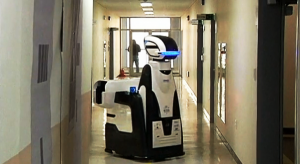Mood Sensing Robot Prison Guards!
…your very own flying cars should be right around the corner, ladies and gentlemen.
When Koreans set about doing something weird, they don’t kidd around. In November, South Korea announced that they were going to see if they could make a robot prison guard (check out Reuter’s video!). Because that seemed like a thing that would be fun, I suppose. As mentioned, those guys weren’t kidding around, and they’ve just announced that the first trials are underway. 3-D cameras and software made to analyze behavior patterns, along with autonomous abilities and communication between prisoners and guards via the robot.
According to a press release:
The robot, called Robo-Guard by many in the press, is equipped with several cameras, one of which is 3D, microphone, speaker and circuitry and software that allow it to roam autonomously in predefined areas within the prison. It also has software that allows it to analyze behavioral characteristics of inmates to help in deciding whether to alert the human guards. Its main purpose, according to the AFC, is to reduce manpower costs in prisons and to make a safer environment for both inmates and those that guard them.
South Korea says that the next step might be a robot that can do body searches, but they don’t think the time is really right for that just yet… which might be a very sensible approach. So, on South Korea time, we should probably see a prototype within the next six months or so.
So what are the benefits of the robot prison guard? Let’s look at the main points a little closer…

- Mood sensing. Can see patterns in prisoner behavior and predict trouble. That’s awesome. But a properly trained human guard is extremely adept at that same skill, and will almost certainly be more accurate in their predictions.
- Facilitates communication between guards and prisoners. It’s hard to see how this is better than actual, direct communication between guards and prisoners. Human contact between guards and prisoners will often calm errant behavior, since even prison inmates need some form of validation.
- Works autonomously, and will “raise the alarm” if it detects something weird.Ah… where a human could intervene immediately, the robot stops, flashes lights and wails. And then we all have to wait around for the guard…
All in all, this is very interesting, but its uses seems to be limited, and though the concept is very interesting, it’s going to take a long time still before these things replace human guards. Oh, by the way – they can be controlled from an iPad. That’s a handy, Real Steel-ish touch.
